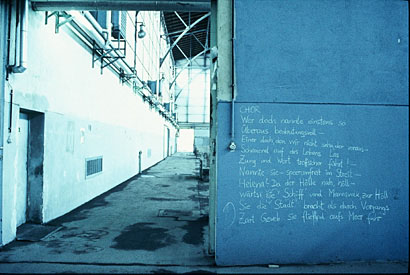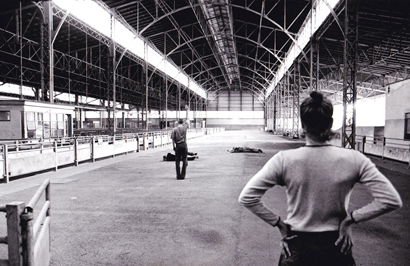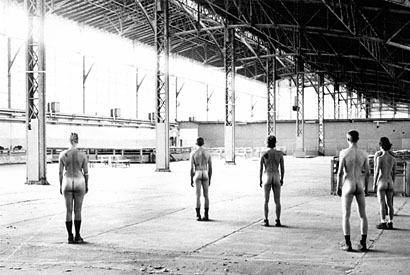1/1999 – 12/2000 massakermykene, choral work with «fatzer-fragment» from bertolt brecht /«agamemnon» (orestie) from aischylos, schlachthof st. marx, vienna (a)
|
massakermykenematerial 1-8
photos
der standard 4/2000
ronald pohl
frankfurter rundschau 4/2001
dirk baecker
text und spiel 07/2000
carena schlewitt
nachträge zu massakermykene 11/2000 hans-thies
lehman u.a.
humanistische blätter 2/2001
georg danek |
|
over a period of two years time from january 1999 to december 2000. finishing with a performance over 36 hours, from 11/3 – 11/5/2000. from october 1999 15 presentations of the process, between 36 minutes and 24 hours, during night and day.
«oresteia» by aischylos / 500 a. c. (1. part, agamemnon) and «fatzer-fragment» by bertolt brecht / 1926 –1931 (3. and 4. phase in the chronological order of bertolt brecht, stücke X, 1997, and corrections by our adaptation to the manuscripts in the brecht-archive, berlin).
the structures of the texts propose social models. they give a certain rhythm, a resisting potential for actors and spectators. they organise like the space gestures / moves / constellations. |
 |
|
concept/directed by: claudia bosse, josef szeiler, perfomers/collaboration: markus keim, andreas pronegg, christine standfest, doreen uhlig, kristina zoufaly, guest: maya boesch, photography: christian koblizek, hélène göhring, clothing: edwina hörl, trainer: wang dongfeng, bert gstettner, loulou omer, sonja schmidlehner, temporary: bernadette konzett, susanne meier, christian ofenbauer, arno rabl, tina seezen, text advice: georg danek
this work was supported by wien kultur and bka kunst
schlachthof st. marx, 1110 vienna, 2 years rehearsal, 15 presentations
supported by wien kultur and bka kunst
|
photo: helene göhring
| |
|
vienna, slaughterhouse st. marx. 22.000 m². built around 1880. the heterogeneous area assembles different time-zones: the huge halls, the concrete yards, city highway. in the middle of these conflicting spaces, within the noise of the city, it is impossible to create spaces of illusion. reality as «disturbing» fact is always there. no decoration. no intervention in the structure of the rooms. no separate space for the audience for reproduction, no space of action which would not be accessible. |

photos: clemens scharre. click to view photo series
|
|
 |
| concept |
|
the basic body in space is the chorus. the individual has every freedom related to the rules of the chorus.
the theatrical happening is not shaped by identification of actor and character, not by roles and parts, but by mutual dis- and replacing of all actors with all the texts, precising the difference of texts and situations. each player should see the whole, not only his/her separated part, but all parts in their conflicting differences.
the spectator is co-producer of the space-body. the space is collective space for experience for actors/spectators.
in a theatre as process, the spectator is never consumer, but (active) potential. the situation is never merely what is shown by the actors, but the situation consisting of the ones „who show“ and the ones who move within that situation. there are parts, gaps, voids only to be filled by the presence of the spectator.
the question is not to make political theatre, but to make theatre political. (after jean-luc godard)
confronted with the strictness of the texts we move in dispositifs, in theatrical structures of improvisations, where the actors create meaning by their actions, where there are no fixed contents, no representations of a story from 1919 or 500 a.c. but a present situation. in doing what they are doing, and by doing it in that moment in a special form, exists a double reflection of the moment of work and the actual situation in this city, here and today, that weather, that space, that procedure of subjecting and confronting oneself to these conditions, these texts. thus meaning is permanently produced collectively. |
www.theatercombinat.com theatrale produktion und rezeption |